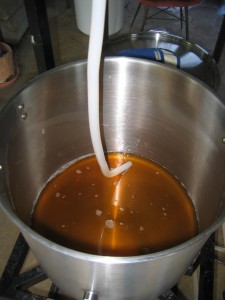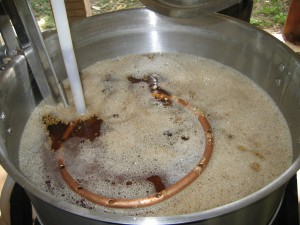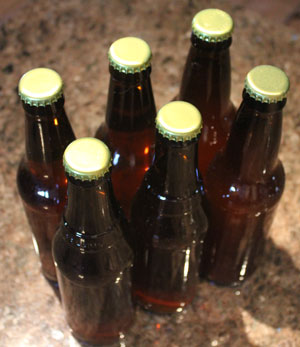 This week’s news round up starts with, you guessed it, another “listicle” — the best craft breweries in Michigan, according to Thrillist. And, here’s another list from them, about Chicago beers. Speaking of lists, remember when the Brewer’s Association blacklisted Schell’s Brewery — a family-owned, Midwestern brewery that brews a wide range of beers — for not being “traditional,” even though they’ve been around since 1860? Well, the BA has re-jerrymandered the definition to include Schell’s. I like this change since I grew up in the Midwest, but people who like consistent guidelines that don’t transparently play favorites are probably less happy. For example, here’s another article on the same topic. (See a homebrew clone of Schell’s Vienna lager, Firebrick, on our site.) And while we’re discussing the upper midwest, apparently sour beers are catching on in Wisconsin. New Glarus is in Wisconsin, so I guess that figures. Heading westward, here’s a list of three new beers being launched in California.
This week’s news round up starts with, you guessed it, another “listicle” — the best craft breweries in Michigan, according to Thrillist. And, here’s another list from them, about Chicago beers. Speaking of lists, remember when the Brewer’s Association blacklisted Schell’s Brewery — a family-owned, Midwestern brewery that brews a wide range of beers — for not being “traditional,” even though they’ve been around since 1860? Well, the BA has re-jerrymandered the definition to include Schell’s. I like this change since I grew up in the Midwest, but people who like consistent guidelines that don’t transparently play favorites are probably less happy. For example, here’s another article on the same topic. (See a homebrew clone of Schell’s Vienna lager, Firebrick, on our site.) And while we’re discussing the upper midwest, apparently sour beers are catching on in Wisconsin. New Glarus is in Wisconsin, so I guess that figures. Heading westward, here’s a list of three new beers being launched in California.
Archives for March 2014
Beer News (Mar. 2–Mar. 9)
Lautering and the Length of Your Brewday
In the previous article, I discussed when you can safely stop mashing and proceed to the mash out and recirculation steps. Heading to the next step when an iodine test indicates that the mash is converted can frequently save you at least 20 minutes out of the usual 60-minute mash time specified in most homebrew recipes. Today I present another way to save time in your all-grain brew day — pick a lautering method that makes sense given how quickly you can heat your wort.
Lautering
Lautering is the step in all-grain brewing in which the brewer separates the sweet wort from the spent grains. Most forms of lautering involve sparging — rinsing the grain bed with hot water. This extracts sugars from the grains that did not freely drain along with the first wort. (The first wort comprises all the runnings from the lauter tun that are undiluted with sparge water.)
300
Today — 253 days after launching Beer and Wine Journal — we’ve hit our 300th post. When publications hit a milestone, their editors frequently decide to get lazy and throw together some sort of lame retrospective that’s both easy to compile and self-serving . . . and that sounded perfect to me.
However, on New Year’s Eve, we posted our Best of 2013 list, so another “best of” list was out of the question. In it’s place, I give you something that requires even less effort — an Editor’s choice list! In this case, it’s a list of articles that I thought were pretty good, but got posted early enough in the life of the website that they never got too many readers. (I’ll also put the top 5 stories posted since the “best of” list in the “Related articles” links, below the story.)
If haven’t seen these, I think there’s some good stuff in them. If you have seen them, don’t worry, I’ll post article #301 tomorrow. And either way, thanks for reading Beer and Wine Journal!
How Long Should You Mash?
Yesterday, James posted an article about a speedy, small-batch brewday. In the next two days, I want to give a few tips on speeding up your all-grain brewday. Today, I’ll focus on mashing, and tomorrow I’ll discuss lautering.
Mash Times
Many all-grain homebrew recipes specify a 60-minute single infusion mash. However, depending on the beer you are making and the malts you are using, you may not need to mash that long. In a single infusion mash, your goal is dissolve the starch granules from the malted barley, and allow the amylase enzymes to degrade the starch into simple sugars. The amount of time this takes depends on your mash temperature and the diastatic power of your malt.
Wednesday Time Waster
Here’s a little something to help you kill some time today, a word find. Hidden in this block of letters are a variety of terms relevant to brewing, and a couple wine-related terms.
Words can be placed horizontally and read left to right or right to left. Words can be placed vertically and read down or up. And words can be placed diagonally and spelled in either direction. A few common acronyms are in the puzzle, as are a couple common prefixes or suffixes. Diacritical marks, such as the two dots in an umlaut, can be placed if needed to spell a word correctly (and that vowel can be used in another direction without modification). All of the words are in English, or are non-English terms (mostly German) commonly used in brewing. All the letters are lowercase, even though some of the words may be proper nouns. A few short phrases or compound words appear. A few common words appear, but the idea is to find the brewing-related terms. I’ll post the solution on Friday.
Click on the picture for a larger view. For best results, print it out and circle the words. (Do not write on your computer screen.)
Speedy Homebrewing
I’m a big fan of small batch brewing. It allows experimentation with less risk, provides a less expensive entry point for first-time brewers, and enables brewing in small spaces where a “full size” brewing setup is impractical.
One of the objections I hear the most about small batch brewing goes something like this: “Why would I spend the same amount of time brewing a six pack of beer that I spend in brewing two cases.” That objection stems from a misconception. Sure, mash rest times and boil times remain the same, but the time it takes to heat up water or wort and cool it down can be radically different. [Read more…]
BWJ Q and A (Extract Upgrade)

Thanks for the question, Russ. Here’s a picture of two cats hugging a kitten. Or maybe they’re trying to smother him. I don’t know.
I really like your articles and recipes on partial mashing, but my question is which is better, a full-wort boil using extract with steeped grains methods or using partial mash methods without boiling the full wort?
— Russell Albright (Keizer, Oregon)
Beer News (Feb. 24–Mar. 1)
 Every week, someone makes a list of beers they claim you gotta try. This week, it’s the website Cool Material and they give their “bucket list” of 25 beers to try before you kick the bucket. The list is an odd mix of some of the more popular and trendy beers, with some head-scratchers thrown in. In a related note, Deadspin lists 24 beers that might have you reaching for a bucket.
Every week, someone makes a list of beers they claim you gotta try. This week, it’s the website Cool Material and they give their “bucket list” of 25 beers to try before you kick the bucket. The list is an odd mix of some of the more popular and trendy beers, with some head-scratchers thrown in. In a related note, Deadspin lists 24 beers that might have you reaching for a bucket.
One cool thing about beer is, just about any beer you can find, you probably afford. Or at least that was true before beer started to be viewed as a commodity by some collectors. In an article for Draft magazine, their beer editor presents some crazy beer prices for (what he calls) black market beers.





Recent Comments